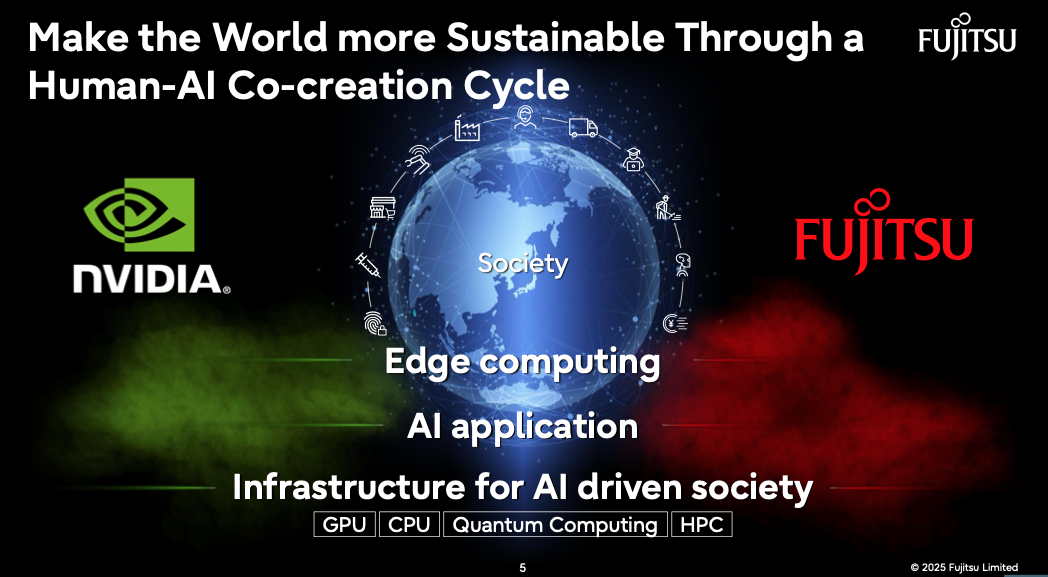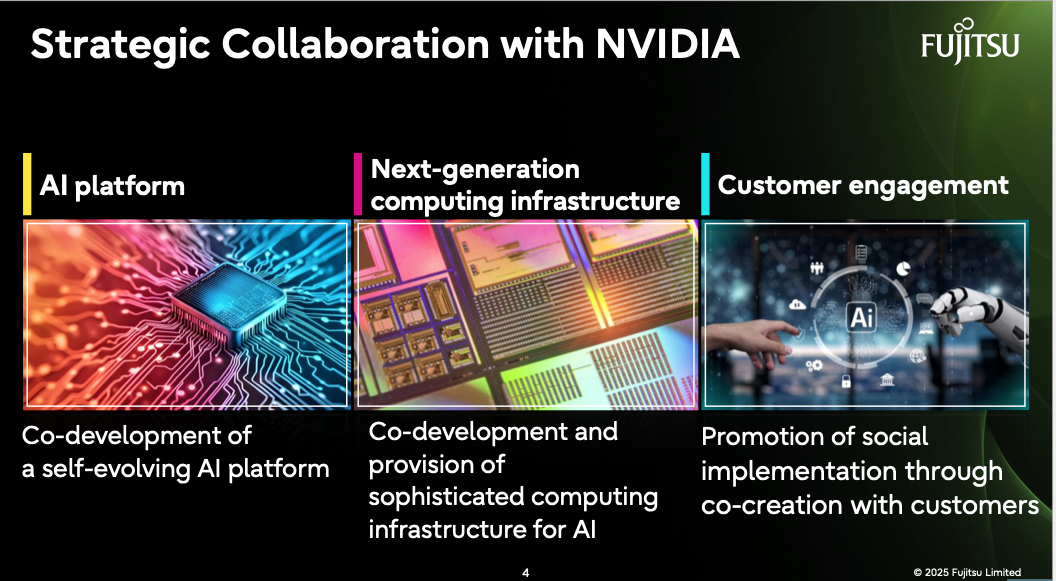Fujitsu announced an expanded strategic collaboration with NVIDIA to co-develop and deliver a full-stack AI infrastructure with integrated AI agents, targeting sector-specific use cases and enterprise-scale deployment. The initiative combines Fujitsu’s silicon, orchestration, and enterprise platforms with NVIDIA’s accelerated computing stack to enable organizations to gain a competitive advantage from AI while maintaining control over data, models, and operations.

The collaboration centers on an AI agent platform designed for industries such as healthcare, manufacturing, and robotics, coupled with an AI computing substrate that tightly integrates Fujitsu’s FUJITSU-MONAKA CPU series and NVIDIA GPUs via NVIDIA NVLink-Fusion. Together, the platform and infrastructure are designed to enable self-evolving AI agents that continuously learn from domain-specific data, thereby closing the gap between pilot projects and production-grade automation. By unifying agents, model services, and high-throughput compute, the partners aim to move beyond the limits of general-purpose systems and accelerate what both companies characterize as an “AI industrial revolution.”
Fujitsu plans to roll out these capabilities first in Japan, with a broader global expansion to follow. The company positions the effort as a way to raise competitiveness across sectors while contributing to a more sustainable, AI-enabled society. Leadership from both firms framed the partnership as a catalyst for enterprise and government transformation: Fujitsu CEO Takahito Tokita outlined a near-term focus on full-stack AI for manufacturing—with expansions into HPC and quantum—while NVIDIA CEO Jensen Huang emphasized the onset of the AI industrial era and highlighted Fujitsu’s strengths in supercomputing, quantum research, and enterprise systems. In short, both leaders see the combined ecosystem as a foundation for faster AI adoption and innovation at scale.
Enterprise AI Beyond Pilots
Generative AI has demonstrated clear productivity gains; however, high costs, integration complexity, and operational risks have limited its broad deployment outside large enterprises. Fujitsu and NVIDIA are addressing these barriers with a vertically integrated approach: domain-tuned agents, policy-aware orchestration, and a high-bandwidth compute fabric that supports continuous learning and model iteration. For technical buyers, the promise is reduced integration overhead, improved performance per watt and performance per dollar at scale, and a more straightforward path to governed, production-ready AI.
Human-AI Co-Creation and Naturally Evolving Systems
Working with NVIDIA, Fujitsu aims to pair high-speed AI computation with human judgment to create a “human-in-the-loop” co-creation cycle. The roadmap emphasizes:
- Accelerated manufacturing via digital twins for rapid design-to-production feedback loops.
- Physical AI, including robotics, to automate operations and mitigate labor shortages.
- Stimulation of human innovation by offloading routine tasks to agentic systems, freeing experts to focus on design, safety, and strategy.
The target outcome is a cross-industry, full-stack AI infrastructure that unlocks transformative automation and intelligence previously unreachable due to siloed tools and general-purpose hardware constraints.

Three Pillars of the Collaboration
Co-developing a Self-Evolving AI Agent Platform
Fujitsu and NVIDIA are collaborating on the development of an agent platform designed for high performance, multi-tenancy, and security. Key elements include:
- Platform foundation: Built on Fujitsu Kozuchi and its AI workload orchestrator (derived from Fujitsu AI computing broker technologies), integrated with the NVIDIA Dynamo platform to manage agent lifecycles, policies, and resources across environments.
- Autonomous evolution and domain tuning: Using NVIDIA NeMo for model lifecycle and enhancing Fujitsu’s multi-agent technologies, including optimization of Fujitsu’s Takane AI model, the platform enables agents and models to learn continuously and adapt to sector-specific needs (e.g., healthcare workflows, manufacturing quality loops).
- NIM microservices delivery: Packaging agents as NVIDIA NIM microservices for streamlined deployment, consistent inferencing performance, and simplified integration within enterprise application stacks.
This initiative helps deliver standardized APIs and deployment patterns, stronger tenancy isolation, and a clearer route to governed model upgrades and agent evolution without disruptive rewrite cycles.
Next-Generation Computing Infrastructure for AI and HPC
The hardware layer is co-designed to minimize bottlenecks between CPUs and GPUs and to scale from enterprise clusters to future zeta-scale ambitions:
- Tight CPU–GPU coupling: Integration of FUJITSU-MONAKA CPUs with NVIDIA GPUs via NVLink-Fusion to deliver high-bandwidth, low-latency data movement—critical for agentic workloads with frequent context switching and memory sharing.
- Silicon-up co-creation: An optimized AI computing platform targeting zeta-scale performance envelopes, designed for sustained throughput in multimodal, multi-agent inference and training.
- Unified HPC–AI software stack: One-stop support that blends Fujitsu’s high-speed ARM software capabilities with NVIDIA CUDA, easing the operational burden of mixed HPC/AI workloads and enabling throughput gains without fragmenting toolchains.
Hardware initiatives deliver improved utilization across heterogeneous jobs, lower tail latencies for agentic pipelines, and a pathway to consolidate HPC simulation, digital twins, and AI agents on a common fabric.
Customer Engagement and Ecosystem Growth
The partnership includes a go-to-market and ecosystem strategy to accelerate adoption:
- Partner ecosystem: Joint programs to broaden access to industry-tuned agents and models, encouraging ISVs, integrators, and vertical specialists to build on the platform.
- Sector-first use cases: Initial focus on manufacturing and robotics, with expansion to healthcare and other regulated domains as standard reference patterns mature.
- Societal deployment: Emphasis on physical AI and robotics to support workforce augmentation and public-sector applications, aligning innovation with measurable customer outcomes.
This translates to reference architectures, validated designs, and a partner-backed path to pilots and production.
Outlook
Fujitsu expects the collaboration to open new AI markets that have been difficult to penetrate due to performance, integration, or compliance constraints. The companies envision this infrastructure as a backbone of Japan’s digital society by 2030, driving enterprise AI growth, supporting corporate development, and creating broader social value.
Fujitsu and NVIDIA are aligning a full-stack, agent-centric vision, encompassing platform, silicon, and ecosystem, for enterprises that require AI to perform at production scale without compromising autonomy. For organizations prioritizing governed deployment, sustained throughput, and domain fit, this collaboration establishes a clear trajectory from proof of concept to measurable outcomes.




 Amazon
Amazon